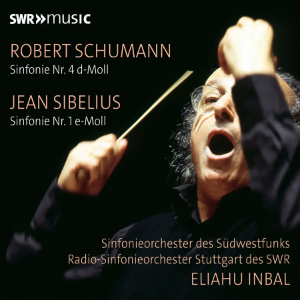
Robert Schumann (1810–56)
Symphony No 4 in D minor, Op 120 (1851)
Jean Sibelius (1865–1957)
Symphony No 1 in E minor, Op 39 (1899)
Sinfonieorchester des Südwestfunks, Radio-Sinfonieorchester Stuttgart des SWR (Sibelius)/Eliahu Inbal
rec. live 21 April 1971, Hans-Rosbaud-Studio, Baden-Baden & 13 July 2012, Liederhalle (Beethovensaal), Stuttgart (Sibelius), Germany
SWR Music SWR19151CD [71]
This well-filled disc presents live recordings of two superb symphonies conducted by Eliahu Inbal with two local orchestras, which eventually combined in 2016. They are separated by over forty years, as Inbal has had a long and distinguished career, and I have found him to be among the most consistently fine and dependable exponents of the core Romantic repertoire.
The disc is designated DDD, but that is obviously not the case for the live analogue recording of the Schumann, given its date. No matter; the sound is very good – and there is very little coughing and just some well-deserved applause at the end of each performance. I love both accounts: the opening to the Schumann is one of my favourites in all symphonies and the manner in which it is played sets the tone for the whole performance – grand, nervy and restless. The spirit is certainly right, even if the upper strings are a bit screechy and woodwind can occasionally turn a bit sour. It is also taken slightly too fast; Bernstein with both the NYP and later the VPO secures more opulent tone from finer orchestras and plays it at a more temperate, imposing tempo. Inbal is master of all the moods in this wonderful symphony, however, and I esteem the way he recaptures the mood of that mysterious, brooding opening of the first movement when Schumann recycles it for the second movement Romanze and again in the Trio of the Scherzo, only for it to reappear yet again in the finale in another modification. Just as Schumann imposes a thematic unity upon the symphony as a whole, Inbal authoritatively establishes an aesthetic coherence upon the work by eschewing any undue lingering and maintaining momentum throughout. This is Schumann’s noblest work and the segue from the conclusion of the third movement into the triumphant opening to the finale is beautifully judged. The music then dances delightfully. If the concluding two minutes are not as manically fast, powerful and thrilling as Bernstein’s coda, that is because Inbal takes a more conventionally measured, proportional approach – which will suit the taste of those who find Bernstein’s zeal excessive – or even vulgar.
The shift of tone from the febrile exuberance of Schumann’s last symphony to the cool, Nordic enigma of Sibelius’ first is quite a wrench and I advise a proper interval. Again, the strings are not always the tidiest, but Inbal’s direction is admirable and the digital sound lends extra depth and clarity. Inbal’s ability to sustain tension in a work which can easily fragment is again much in evidence; I find myself gripped throughout by the propulsion of this performance. The snatches of surging lyricism are given full weight; Inbal makes the great climax of the first movement at 8:40 and the thunderous conclusion into real events and the brass deliver very satisfyingly. The wistful slow movement begins dreamily and builds imperceptibly to the fiery climax before relapsing into the resigned calm of the last two minutes, which Inbal draws out quite daringly. The agitated Scherzo is colourfully punctuated with some attractive flute fluttering, parping low notes on the tuba and nice, hard drum thwacks – some of the best orchestral playing is to be found here. Inbal makes the yearning, questioning finale with its rumbling dissonances suitably disturbing; he does not hold back in the thunderous passages and the mood never settles – he “gets” this music and there is nary a slack moment. When the Big Tune arrives eight and a half minutes in, he gives it full rein, such that it inevitably reminds the listener of the similarly lofty, imposing melody which graces the finale of Sibelius’ next, Second Symphony.
I will, however, confess that one problem with this issue remains insoluble for me. As a music-lover with a fairly extensive collection and an appropriate cataloguing system allowing me to track down specific recordings among many, I am compelled to order CDs of this kind under the name of the conductor rather than either of the two composers, with the result that I often overlook them when seeking out or comparing favourite versions for listening or reviewing purposes – and relying on my memory can be risky.
Ralph Moore
Buying this recording via a link below generates revenue for MWI, which helps the site remain free




















